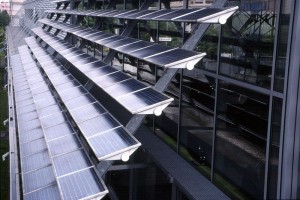TUESDAY, 25 JUNE 2013
One of his most promising designs; plasmonic enhanced organic photovoltaic materials, is not yet able to match the efficiency of traditional cells but is far less expensive to manufacture.Traditional solar panels are produced using either thick silicon wafers or inorganic thin-film solar cells.. Gan’s new solar cells also use thin-film technology but use organic carbon-based small molecules and polymers. An additional bonus is that the material is liquid, allowing it to be applied to a variety of surfaces in much the same way that paint can be.
Despite this, there are drawbacks to organic photovoltaic cells. Their relatively poor electronic conductive property means they must be kept thin, but this means there is less material to absorb light. With less material present their optical absorption and thus efficiency of power conversion is limited. The cells’ efficiency must be improved to at least 10 percent in order to compete with those already on the market.
To meet these requirements, Gan and other researchers are now incorporating metal nanoparticles and/or patterned plasmonic nanostructures into their organic photovoltaic cells. Plasmons are collective oscillations of free electron densities, and can be utilised in material science to increase the absorption of light into a material. It is hoped that this will sufficiently increase the efficiency of organic cells so that they can be a more efficient and economical source of renewable energy.
DOI: 10.1002/adma.201203323
Written by Laura Burzynski.

